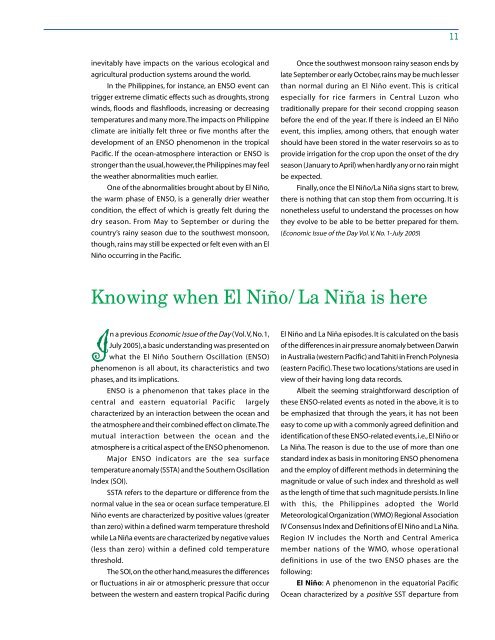Read More - Philippine Institute for Development Studies
Read More - Philippine Institute for Development Studies
Read More - Philippine Institute for Development Studies
You also want an ePaper? Increase the reach of your titles
YUMPU automatically turns print PDFs into web optimized ePapers that Google loves.
11<br />
inevitably have impacts on the various ecological and<br />
agricultural production systems around the world.<br />
In the <strong>Philippine</strong>s, <strong>for</strong> instance, an ENSO event can<br />
trigger extreme climatic effects such as droughts, strong<br />
winds, floods and flashfloods, increasing or decreasing<br />
temperatures and many more. The impacts on <strong>Philippine</strong><br />
climate are initially felt three or five months after the<br />
development of an ENSO phenomenon in the tropical<br />
Pacific. If the ocean-atmosphere interaction or ENSO is<br />
stronger than the usual, however, the <strong>Philippine</strong>s may feel<br />
the weather abnormalities much earlier.<br />
One of the abnormalities brought about by El Niño,<br />
the warm phase of ENSO, is a generally drier weather<br />
condition, the effect of which is greatly felt during the<br />
dry season. From May to September or during the<br />
country’s rainy season due to the southwest monsoon,<br />
though, rains may still be expected or felt even with an El<br />
Niño occurring in the Pacific.<br />
Once the southwest monsoon rainy season ends by<br />
late September or early October, rains may be much lesser<br />
than normal during an El Niño event. This is critical<br />
especially <strong>for</strong> rice farmers in Central Luzon who<br />
traditionally prepare <strong>for</strong> their second cropping season<br />
be<strong>for</strong>e the end of the year. If there is indeed an El Niño<br />
event, this implies, among others, that enough water<br />
should have been stored in the water reservoirs so as to<br />
provide irrigation <strong>for</strong> the crop upon the onset of the dry<br />
season (January to April) when hardly any or no rain might<br />
be expected.<br />
Finally, once the El Niño/La Niña signs start to brew,<br />
there is nothing that can stop them from occurring. It is<br />
nonetheless useful to understand the processes on how<br />
they evolve to be able to be better prepared <strong>for</strong> them.<br />
(Economic Issue of the Day Vol. V, No. 1-July 2005)<br />
Knowing when El Niño/La Niña is here<br />
In a previous Economic Issue of the Day (Vol. V, No. 1,<br />
July 2005), a basic understanding was presented on<br />
what the El Niño Southern Oscillation (ENSO)<br />
phenomenon is all about, its characteristics and two<br />
phases, and its implications.<br />
ENSO is a phenomenon that takes place in the<br />
central and eastern equatorial Pacific largely<br />
characterized by an interaction between the ocean and<br />
the atmosphere and their combined effect on climate. The<br />
mutual interaction between the ocean and the<br />
atmosphere is a critical aspect of the ENSO phenomenon.<br />
Major ENSO indicators are the sea surface<br />
temperature anomaly (SSTA) and the Southern Oscillation<br />
Index (SOI).<br />
SSTA refers to the departure or difference from the<br />
normal value in the sea or ocean surface temperature. El<br />
Niño events are characterized by positive values (greater<br />
than zero) within a defined warm temperature threshold<br />
while La Niña events are characterized by negative values<br />
(less than zero) within a defined cold temperature<br />
threshold.<br />
The SOI, on the other hand, measures the differences<br />
or fluctuations in air or atmospheric pressure that occur<br />
between the western and eastern tropical Pacific during<br />
El Niño and La Niña episodes. It is calculated on the basis<br />
of the differences in air pressure anomaly between Darwin<br />
in Australia (western Pacific) and Tahiti in French Polynesia<br />
(eastern Pacific). These two locations/stations are used in<br />
view of their having long data records.<br />
Albeit the seeming straight<strong>for</strong>ward description of<br />
these ENSO-related events as noted in the above, it is to<br />
be emphasized that through the years, it has not been<br />
easy to come up with a commonly agreed definition and<br />
identification of these ENSO-related events, i.e., El Niño or<br />
La Niña. The reason is due to the use of more than one<br />
standard index as basis in monitoring ENSO phenomena<br />
and the employ of different methods in determining the<br />
magnitude or value of such index and threshold as well<br />
as the length of time that such magnitude persists. In line<br />
with this, the <strong>Philippine</strong>s adopted the World<br />
Meteorological Organization (WMO) Regional Association<br />
IV Consensus Index and Definitions of El Niño and La Niña.<br />
Region IV includes the North and Central America<br />
member nations of the WMO, whose operational<br />
definitions in use of the two ENSO phases are the<br />
following:<br />
El Niño: A phenomenon in the equatorial Pacific<br />
Ocean characterized by a positive SST departure from










